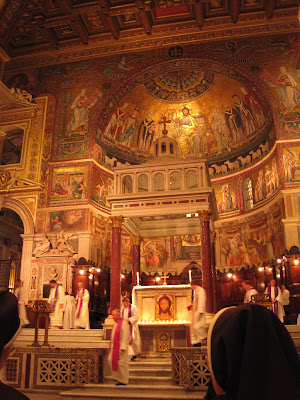Various Churches in Rome are selected for the pilgrimage--a different Church every day. Some days the walk might be only a few minutes. Other days, it can be a 1.5 hour journey. It takes a certain discipline and act of the will to force yourself out of bed an hour earlier than normal in order to walk to the station Churches in the cold, wet, darkness of the mornings in Lent.
However, after a quite penitential walk across the city, what awaits you is something spectacular. The station Churches are not only aesthetically beautiful, but they possess a rich and beautiful history of the Church, as much of the eternal city does. The station Churches are often the most ancient Churches in Rome. Often times, the first Masses that were celebrated by the Christian community in the first centuries A.D. were celebrated in these Churches. Before the legalization of Christianity, Masses were held in private, often in the houses of the wealthier Christians. After they died, these property owners would often leave their house to the Church, which would then be used as a worship site.
More often than not, these stational Churches will have the relics of various Saints who have some affiliation with that particular sight--often times it is the place of their martyrdom. I think the quote that is written above the roof the North American College articulates it well: "O Roma Felix, quae duorum Principum es consecrata glorioso sanguine." In English, "Oh happy Rome, whom that most glorious blood forever consecrates..."
We honor the first martyrs, whose blood was shed, and thus consecrated the city of Rome, along with all the Saints. That most noble act of faith, which gave life to the Church, we remember through our participation in the stational Mass. It is impossible to articulate the experience of the station Churches, and the emotion that ensues. All I can say is that an hour long walk through a cold, wet, dark Rome is NOTHING compared to the sacrifice of those who died for the faith they believed--namely, the passion, death, and resurrection of the 2nd person of the Trinity--Jesus Christ.
Here are some highlights of the Station Churches:











